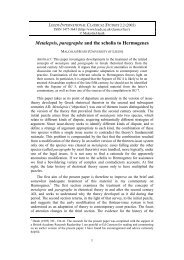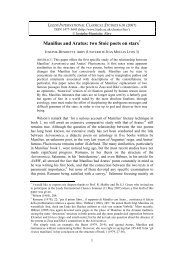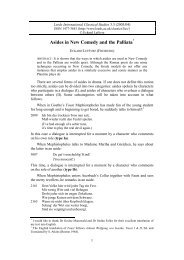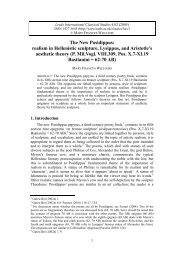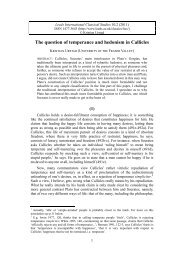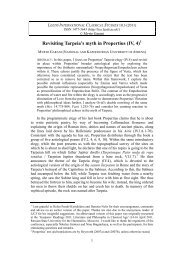Greek Tragedy between Human and Animal - Leeds International ...
Greek Tragedy between Human and Animal - Leeds International ...
Greek Tragedy between Human and Animal - Leeds International ...
Create successful ePaper yourself
Turn your PDF publications into a flip-book with our unique Google optimized e-Paper software.
CHIARA THUMIGER, GREEK TRAGEDY BETWEEN HUMAN AND ANIMAL<br />
seems to be an especially suitable object of inquiry for a study of animal imagery,<br />
as it allows an analysis in relation to a genre, first of all, whose conventions we<br />
know sufficiently well; moreover, in tragedy the presence of animals is arguably<br />
made more significant than elsewhere by the nature of the medium, a selfcontained<br />
text of such length as to allow complex developments in patterns of<br />
imagery, sustained metaphors <strong>and</strong> interactions <strong>between</strong> ‘literal’ animals (actual<br />
animals reportedly acting within a play) <strong>and</strong> ‘figurative’ animals (animals in<br />
imagery of various kind).<br />
My main thesis is that animals in tragedy are more than a mere decoration or<br />
an element of the world, of ‘reference’ ancillary to human experience. On the<br />
contrary, both as imagery (e.g., in similes <strong>and</strong> metaphors) <strong>and</strong> as part of reference<br />
(as ‘literal’ animals) animals participate in the world of the play, impinging on the<br />
definition of humanity in a way comparable to no other semantic group—not, for<br />
instance, vegetation, or other natural elements such as the stars or the sea, nor<br />
features of civilisation or social organisation, such as the nautical, money or the<br />
military, to quote only a few verbal clusters associated with tragic idiom.<br />
Kathirithamby 1986 on insects). A further selection of books <strong>and</strong> articles discusses philosophical<br />
issues in relation to man within the realm of living beings: Lloyd (1961, 1970, 1985) on the<br />
definition <strong>and</strong> classification of animals in <strong>Greek</strong> philosophy up to Aristotle; Pellegrin (1986) on<br />
the aims <strong>and</strong> significance of Aristotle’s classification of animals; Sorabji (1993) on the changing<br />
attitude to animals from the pre-Socratics to the Stoics as shaping the modern debate, ultimately<br />
creating a community of man which defines itself against animals; Castignone <strong>and</strong> Lanata (1994)<br />
for an edited collection on animals in ancient philosophy; Heath (2005) on the definition of<br />
animals from Homer to Plato by virtue of their lack of speech; Gilhus (2006) on late antique<br />
developments in attitudes towards animals; Osborne’s (2007) history of humane attitudes towards<br />
animals, from a philosophical point of view but strongly arguing for the importance of poetry <strong>and</strong><br />
storytelling in shaping beliefs. Ancient mythological figures of the ‘human-animal hybrid’ have<br />
been interpreted as an expression of how ‘our continuities with, <strong>and</strong> our differences from, the<br />
earth’s other animals are mysterious <strong>and</strong> profound’ (Dinnerstein 1976, 2, quoted in Gottschall<br />
2001, 279). One might draw the same conclusion from the ‘animal life of early man as a basic<br />
feature in the historians of human progress’ (Forbes Irving 1990, 94 n.121). Also interesting are<br />
the instances of exotic ‘humans’ that ancient ethnographers <strong>and</strong> anthropologists reported in remote<br />
places, animal-like in their behaviour (Aristotle NE 7.5, 1149a9-11) or morphology: see Campbell<br />
(2006) 114-6 on Ctesias’ reports on the ‘Dog-heads’, inhabitants of India ‘who have the head of a<br />
dog... they speak no language, but bark like dogs, <strong>and</strong> in this way underst<strong>and</strong> one another’s speech’<br />
(FGrH 688F45.37 = Photius Bibl. 72, 47a19-22); <strong>and</strong> Campbell (2006) 129-32 on the ‘Isl<strong>and</strong> of<br />
the Sun’ <strong>and</strong> the description of its inhabitants by Iambulus as reported by Diodorus Siculus 2.55-<br />
60, similarly displaying a mixture of human <strong>and</strong> animal characteristics). Gottschall (2001) 278<br />
sees a parallel in such ancient ideas to the Darwinian ‘monkey-man’ (the common ancestor of<br />
monkeys <strong>and</strong> men), which sc<strong>and</strong>alised nineteenth-century audiences. (The evolutionary<br />
component is, of course, not shared: against evolutionary readings of ancient theories see<br />
Campbell (2006) 26-7, especially on Anaxim<strong>and</strong>er.) Developing the project of ‘evolutionary<br />
literary criticism’, Gottschall (2001) assesses the duels in the Iliad in terms of ‘ritual combat’ <strong>and</strong><br />
of ‘intra-species sub-lethal animal fighting’, focusing on ‘the tragedy of being a human animal’ in<br />
Homer (see also Gottschall <strong>and</strong> Wilson 2005, vii-xv for a theoretical discussion). The obvious (<strong>and</strong><br />
acknowledged) risk is of reducing the ‘human’ to a biologically determined pattern of behaviour,<br />
rather than enriching the animal in terms of emotional or intellectual faculties. The outcome is<br />
liable to be a reductionist representation of animals <strong>and</strong> humans, possibly unfair to both. A search<br />
for interactions <strong>between</strong> human <strong>and</strong> animal on the ground of projections, symbols <strong>and</strong> metaphors<br />
appears to be more fruitful.<br />
2



